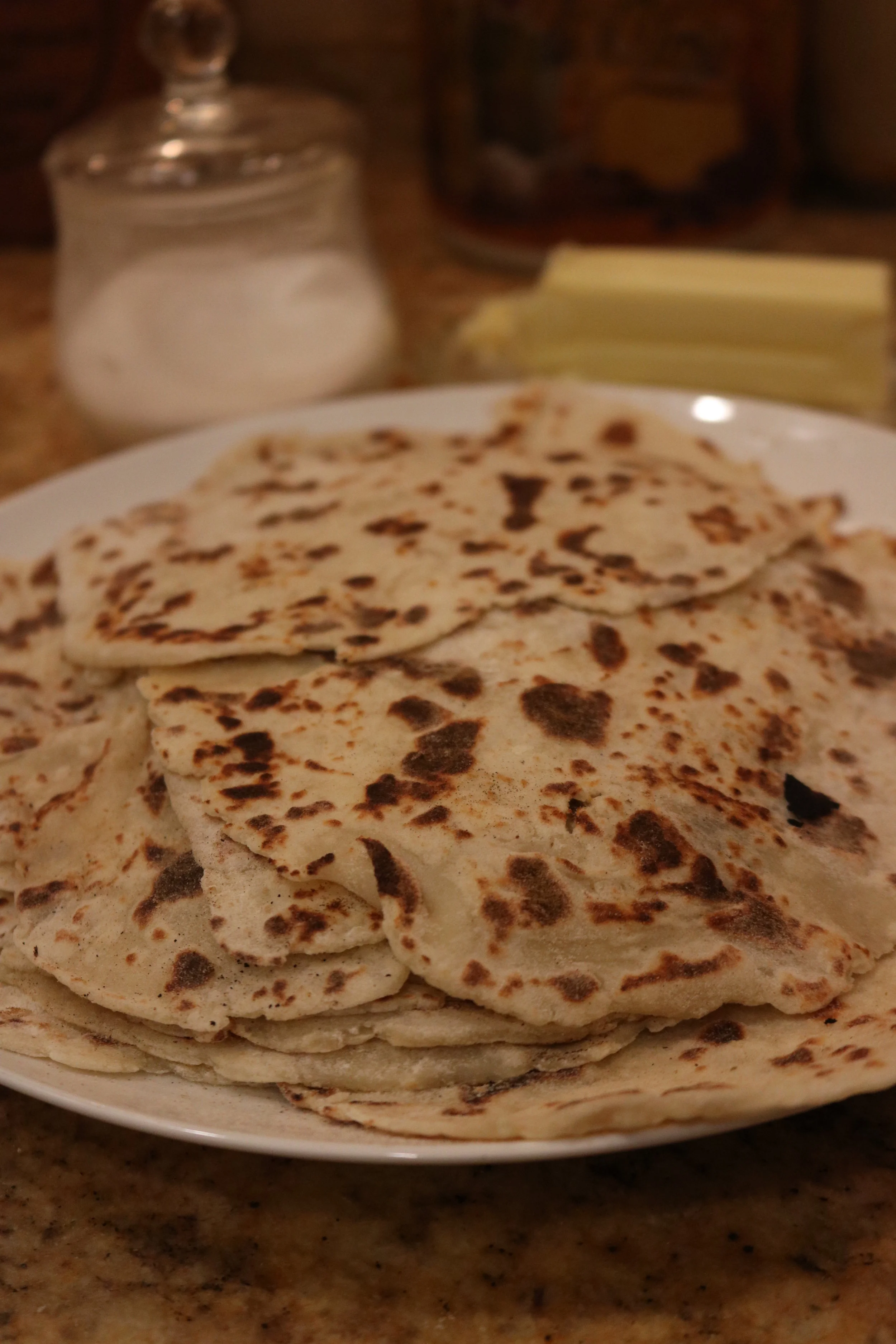(Inspired by the “Preface,” p. ix, Cornfields to Codfish)
Unlike the traditional making of lefse, I don’t use a potato ricer, a lefse grill, or a lefse stick to flip the lefse. I have a potato masher, a cast-iron skillet, and a big hamburger-flipping spatula. My lefse is only as big as what will fit in my 10-inch skillet.
The ingredients are from the card in my circa 1982 brown sturdy plastic recipe box – with a couple adjustments: I go light on butter and don’t add sugar to the dough since the final step before eating lefse is to top it with those two ingredients.
There’s no name in “From the Kitchen of . . .” but I know this recipe is from a college friend’s grandmother who was about 80 years old when I received the recipe in the late 1980s.
Ingredients
2 pounds peeled potatoes
2 T. unsalted room temperature butter (at room temperature
only because it melts into the potatoes quickly and easily)
¼ c. heavy cream
1 t. salt
1 ¾ c. flour
At least a cup of additional flour for rolling the lefse dough
Soft butter and sugar for serving
Boil the potatoes until mashable, then drain and return to the pan. Turn the heat off but keep pan on the hot burner while mashing the potatoes. The residual heat helps make the spuds fluffy while mashing them.
Stir in butter, cream, and salt. The potatoes will look dry and gummy. Transfer them into a big bowl to cool. Over the course of an hour or so, I make several cuts through them with a stiff spatula to let heat escape. Once completely cool, cut in 1 ¾ c. flour with the spatula. Use hands to knead in the last bits of flour and to form a ball of dough.
“When home for Christmas my freshman year, I added a Norwegian food tradition to my family’s celebration: lefse. Following the recipe of a college friend’s grandmother, I boiled potatoes, not for dinner but rather to mash with flour, sugar, a little salt, and a splash of cream . . . (p. 9, Cornfields to Codfish)
Preheat a cast-iron skillet on a medium-high burner before rolling out the first piece. Generously sprinkle flour on the counter, and pull off a large walnut-sized piece of dough. Roll it into a ball, flatten it into a patty, and flour both sizes before rolling. On the first or second roll, the dough will stick to the rolling pin; peel it off and reflour both sides of the dough. Roll it into a very thin circle, similar thickness to that of a flour tortilla.
Carefully move it from the rolling surface to the palm of your hand; then gently flip it from palm to palm to shake off excess flour.
Dry fry the lefse, checking it after about 30 seconds to see if it has browned. It will bubble a bit as it cooks. Flip and repeat on the second side.
Stay near the stove to watch the lefse, and reduce the heat to medium if it browns too quickly. We are really cooking flour here, so no flash browning – that won’t give the lefse enough time to actually cook.
As the lefse cooks in the skillet, roll out the next one. This recipe makes around 20 pieces of lefse, so be prepared to stick near the stove for a good half hour. When burned flour accumulates in the pan after dry frying a few pieces of lefse, I carefully hold the pan over the sink and wipe the flour out with a dry paper towel.
When both sides of the lefse are covered with brown spots and it smells toasted, remove from the pan and place on a dinner plate. The hot pieces of lefse can be stacked on top of one another.
For the buttering and sugaring, put the lefse on a flat surface (the counter) to spread the butter edge to edge and sprinkle on the sugar. Fold the lefse in half, and then in half again. This pie-wedge shape keeps the butter from leaking out as it would if the lefse were rolled like a wrap.
For any lefse not eaten directly from the pan, cool, cover, and refrigerate. To eat later, pop a piece of lefse in the microwave for about 45 seconds to reheat.
We’ve tried cinnamon and sugar as well as jam on lefse, but I always revert to the way I first ate it . . . with butter and sugar.
“This Norwegian culinary phenomenon became a holiday tradition with my family for several years. Until I introduced them to Irish Potato Chowder . . .” (p. ix-x, Cornfields to Codfish)
